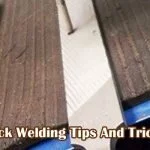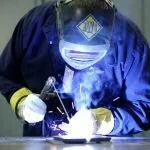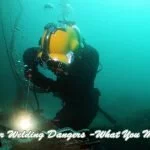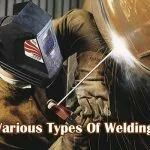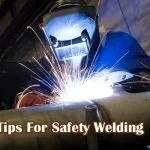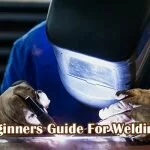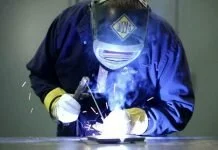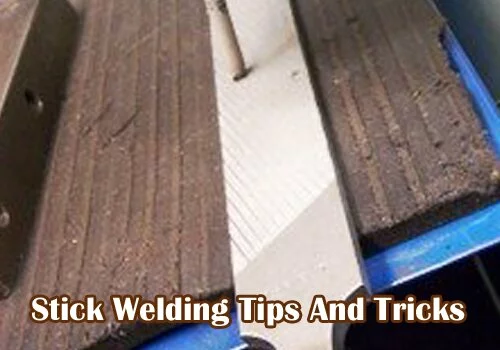Drop by any construction site and your attention will soon be caught by a sight that’s both familiar and striking: bright showers of flying sparks as workers weld support pieces together, that’s how arc welding look like. Sometimes you’ll see them doing the welding work on the ground, and sometimes you’ll see them all the way up in the air. These workers are performing critical actions in building the framework of the structure that’s under construction.
The Ultimate Guide to Shielded Metal Arc Welding:
What is Welding? Basics, Methods.
Shielded Metal Arc Welding (SMAW)
The Shielded Metal Arc Welding Process
Shielded Metal Arc Welding Techniques
What is Welding
These days, it’s hard to find a construction project that doesn’t make use of metal. Some metals, and some alloys that contain different kinds of metals, are vitally essential in the fabrication of everything from skyscrapers to car engines to the circuit boards that power different mobile devices.
What happens when you need to join pieces of metal together? And what happens if those pieces of metal are composed of different metals or alloys? Some might be inclined to use external joining methods on these pieces: methods that use additional pieces such as bolts, screws, or clamps.
When you can’t use those external items, then it’s time to take a look at the process of welding.
Basics
Instead of using additional pieces to join separate pieces of metal to each other, welding instead relies on very high temperatures, which cause the separate pieces to melt. The molten material, which is composed of the metals in the pieces being joined, is referred to as the weld pool. As it cools, the material in the weld pool hardens and forms the join that fuses the welded pieces together. In some welding processes, different forms of filler material are added to the join in progress, making it much stronger than if it had been composed of the base materials or metals alone. Learn more about the basics below.
The wide range of welding methods includes:
- Shielded metal arc welding
- Gas tungsten arc welding
- Gas metal arc welding
- Flux-cored arc welding
- Submerged arc welding
- Electroslag welding
An energy source is critical to producing the very high temperatures that are necessary to weld materials together. Examples of these energy sources include gas-powered flames, electric arcs, lasers, electron beams, ultrasound, and even friction.
The process of welding is often conducted in the open air. Other environments in which welding actions can be performed include under the surface of the ocean, and in outer space.
And while the workers at that construction site might make the welding process look easy, pay attention to the safety clothing that they’re wearing – long sleeves, thick gloves, and protection for the face and – most critically – the eyes.
Welding is not an action that should be undertaken lightly. In order to avoid getting burned, suffering from electric shocks, sustaining eye damage, or inhaling poisonous fumes, workers must undertake many different precautionary measures.
In this article, the focus will be on welding by means of electric arcs.
What is Arc Welding
In arc welding, one of the most familiar and commonplace welding processes, electricity is passed from a welding power supply to, and ultimately through, an electrode, which is then applied to the items that are being joined.
The welding power supply provides electric current, which powers the welding process. These power supplies can provide constant current, or constant voltage. With a constant current machine, the output voltage varies, but the output current is maintained at a desired level. The reverse is true of the constant voltage machine, in which the output current varies while the output voltage is kept steady.
Another consideration in terms of the welding power supply is whether it uses alternating current (AC) or direct current (DC). If direct current is used, the electrode can carry either a positive or a negative charge, the result of which affects the strength of the weld and the speed of the welding process. These values vary according to the welding process in use.
If alternate current is used, the electrode carries a positive and a negative charge by turns, regardless of the welding process. This results in medium-penetration and medium-speed welds.
Electrodes are used in arc welding to pass electric current through a workpiece. The electric current provides the necessary high temperatures to weld together the pieces that are being joined. In some welding processes, the electrode is consumable and then often takes the shape of a thin rod; in others, the electrode is non-consumable, and is used together with mixtures of inert or semi-inert gases.
It is important to protect the weld area to ensure that there is no atmospheric contamination, in order to prevent unwanted materials from entering the joins. These unwanted materials can weaken the joins, or cause or enhance corrosion.
Some steel, titanium, and aluminum alloys can be affected by hydrogen embrittlement. If there are traces of water in the electrode or on the workpiece, the water decomposes into its components of hydrogen and oxygen in the high temperatures created by the arc. The liberated hydrogen then enters the weld pool. The inclusion of hydrogen will cause the welded area to become brittle.
A few types of stainless steel, as well as some nickel alloys, can be affected by intergranular corrosion. If these materials are exposed to temperatures of around 700 degrees Celsius for extended periods of time, chromium carbide can form and weaken the materials’ resistance to corrosion. Another term for this kind of corrosion is weld decay.
If intergranular corrosion affects steels that are stabilized with niobium, then this type of weld decay is more correctly referred to as knifeline attack. Chromium carbide is formed in the very vicinity of the weld, instead of niobium carbide — and again, this weakens the alloys’ resistance to corrosion or degradation.
Shielded Metal Arc Welding (SMAW)
This welding process goes by a variety of names, including flux shielded arc welding and manual metal arc welding. Informally, it is also referred to as stick welding.
In this arc welding process, the electric current passes through a consumable electrode, usually in the form of a thin stick. The consumable electrode melts and provides filler material to strengthen the weld. The electrode is usually covered in flux, which in melting helps to create the arc. The flux also protects the weld from contamination.
Shielded Metal Arc Welding or SMAW is the preferred welding process used when the items to be joined are composed of iron (including ductile iron and cast iron) or different kinds of steels (including stainless steel and carbon steel). It is also possible to weld items that are composed of nickel or copper or their alloys using this method.
There has been less success in using this welding process with items composed of aluminum and its alloys.
It’s easy to imagine that since a large number of construction and fabrication processes deal with iron and different steels, SMAW has become one of the most versatile, most popular, and most familiar welding methods.
As can be seen from one of its alternative names, SMAW is almost exclusively a manual welding process – however, an automated version does exist, and it is referred to as gravity arc welding or, more simply, as gravity welding.
The Shielded Metal Arc Welding Process
This being an arc welding process, the process begins with creating the necessary electric arc between the electrode and the workpiece. This is done by very lightly and very briefly touching the former to the latter. Then the electrode is pulled away slightly, creating the empty space in which the arc can exist.
There are two techniques to use in striking the arc: scratch-strike and tapping.
In the scratch-strike technique, the electrode is quickly and briefly dragged along the surface of the workpiece, exactly as though the electrode were a match being struck against a rough surface.
In the tapping technique, the electrode is quickly and briefly tapped against the surface of the workpiece.
Distance
Whichever technique is used, after the electrode makes contact with the workpiece it should be pulled away for a very short distance, so the arc can be created and then correctly maintained. If the arc appears but then goes out, the distance between the electrode and the workpiece is too large.
Find your angle
Even at this first step of the process there can be numerous difficulties. First and foremost is finding the right angle at which to touch the electrode to the workpiece. An electrode that is held in such an angle that it’s perpendicular to the workpiece might cause the tip to get stuck — thus fusing the electrode and the workpiece and cause rapid increase in heat.
The solution, therefore, is to perform the initial touch of electrode to workpiece at a relatively low angle. This will allow the electrode material to flow properly once the arc has been struck.
Fluxes
Electrodes that are used in this welding process are covered with a substance called flux. Fluxes act as cleaning, flowing, or purifying agents. These agents are critical in welding because as they melt, they give off shielding gases, which prevent the materials that are being joined from oxidizing. Fluxes also melt into slag, which gives the weld area extra protection from atmospheric contamination.
Chip away slag and replace spent electrodes
To join pieces together, the arc is passed over the work area as many times as needed to allow the material of the pieces to melt and the electrode to be deposited along the join.
Once the pieces to be joined have completely cooled and joined together, the slag that had protected the join has no further role to play, and becomes waste material. It hardens and should be chipped off after the weld has been laid.
Because the electrodes used in the shielded metal arc welding process are consumable, it is necessary for the person performing the welding to periodically replace the electrode.
The need to chip away slag and replace spent electrodes make this welding process one of the less efficient welding methods.
Helpful arc welding tutorials can be found HERE:
SMAW Equipment
Power Supply
In SMAW, the power supply provides constant current. The current, and consequently the temperatures, remain relatively constant, despite changes in the voltage or in the arc distance.
Some constant current welding power supplies provide direct current (DC), while others provide alternating current (AC). As mentioned above, the polarity of the current provided by a DC power supply can be positive or negative, while the polarity of the current provided by an AC power supply changes many times per second.
If a negatively charged electrode is used with a DC power supply on a positively charged workpiece, heat builds up on the electrode. It melts more quickly, but decreases weld depth.
If a positively charged electrode is used with a DC power supply on a negatively charged workpiece, the depth of the weld is increased.
Electrodes used with an AC power supply experience a more even distribution of heat. This helps make sure that there is balance between the rate at which the electrode melts and the weld depth or penetration.
It is also necessary to consider the type of electrodes to be used in the welding process, when considering whether to use a DC welding power supply or an AC one. While most types of electrode can be used with both categories of power supply, there are some electrodes that will only work properly with a DC welding power supply.
In addition, DC welding power supplies will work equally well with heavy-gauge and light-gauge material.
It is now possible to purchase welding power supplies that produce both DC and AC, making it both convenient and easy to choose the correct welding current for the process at hand.
Electrode
The materials to be welded together, the position in which the welding action will be conducted, and the desired properties of the weld all influence the choice of electrode when doing shielded metal arc welding.
There are three categories in terms of electrodes used in this process.
- “fast-fill” electrodes, which melt quickly. This kind of electrode maximizes welding speed.
- “fast-freeze” electrodes, which solidify quickly. Using fast-freeze electrodes makes it possible to perform the welding action in many positions, because the weld pool will not experience any significant movement or loss before it solidifies.
- “fill-freeze” electrodes which strike a balance between the two extremes. These are also called fast-follow electrodes
In general, the core of an electrode will be composed of the same materials as the pieces to be joined. Iron items can be welded together using electrodes with iron cores; copper items can be welded together using electrodes with copper cores.
Sometimes, however, it is a good idea to use electrodes whose cores are different from the materials from which the pieces to be joined are made. For example, electrodes with stainless steel cores are often used to join pieces made of stainless steel to pieces made of carbon steel.
Welding Cable and Electrode Holder
The welding cable connects the electrode holder to the power supply, and conducts the current generated by that power supply to the electrode. The handle of the electrode holder is insulated and is used to guide the electrode over the area or areas to be joined, and to feed the electrode into the weld pool. The welding cable must likewise be well-insulated, ideally with heat-resistant material; and it must be flexible.
Ground Cable and Ground Clamp
The welding power supply is connected to the workpiece through the ground cable and thence to the ground clamp. As these two objects are part of the circuit that is completed by the electric arc, they must both be capable of carrying the current from the power supply to the workpiece, while at the same time avoiding overheating. The flexibility and insulation considerations for the welding cable apply to the ground cable, as well.
Shielded Metal Arc Welding Techniques
When performing SMAW, the ideal outcome is for the electrode core’s material to be deposited onto the work surface in a uniform, even layer. This layer is referred to as the bead.
Most of the time, welding work is conducted with the materials to be joined placed in flat or horizontal positions. However, depending on the construction or fabrication project being undertaken, the welder may very well be forced to work with the materials either in vertical positions, or even placed overhead.
When welding in a flat or horizontal position, it’s recommended to hold the electrode holder at about 10 to 20 degrees from vertical. This slight angle will prevent slag from overtaking the tip of the electrode, as welding over the slag might cause inclusions to form in the weld.
Try to maintain the right arc length. This is the distance between the weld pool and the tip of the electrode. A rough guideline would be to keep the arc length to the diameter of the electrode itself. For example, if you’re using an electrode rod with a diameter of 3.2 mm, then the arc length should be no longer than 3.2 mm.
As the welding process continues, the electrode is of course consumed. Make sure that the arc length remains consistent even as the electrode gets shorter and shorter. It is also important to maintain the shortened electrode at the 10- or 20-degree angle mentioned above.
“Millerwelds” provide great Guidelines for Shielded Metal Arc Welding. All what you need to know in THIS PDF FILE.
Shielded Metal Arc Welding Tips
- Before switching on your power supply, make sure that your workpiece is clean and free of dust.
- If you need to use a work clamp, make sure to place it as close to the area being welded as safety permits.
- An electrode with a small diameter requires less current usage than an electrode with a large diameter.
- When ready to weld, strike the arc – and make sure to keep it short. Then move along the items to be joined at a uniform speed, keeping the electrode tip a little lower than perpendicular to the surface/s. Make sure that as the electrode melts, you keep feeding it downward at a constant rate.
To learn more about this topic you may want to visit: “Stick welding tips & tricks“.
Arc Welding Safety Rules
- The electric arcs used in welding processes such as shielded metal arc welding can give off extremely bright light as well as ultraviolet radiation. One of the reasons to wear thick gloves and protective long-sleeved jackets is to minimize sunburn caused by the UV rays.
- It is equally important to wear face and especially eye protection. Helmets or welding masks can now be purchased in either fixed-shade or auto-darkening forms. The latter automatically adjusts to lighten or darken the viewing window depending on the brightness of the electric arc.
- If there are other people in the area where welding processes are being performed, warn them not to look at the arc/s. Whenever possible, make sure that the work area is screened from public view.
- Do not breathe in the fumes created by arc welding! Make sure that the work area is well-ventilated — and if it’s not, or it can’t be well-ventilated, wear a respirator that has its own air supply.
- It can be fascinating to watch the sparks fly when objects are being welded — but remember to fire-proof the work area as well. Clear away all inflammable materials and make sure that there are fire extinguishers close at hand. For areas where arc welding processes are being performed, carbon dioxide or dry-powder fire extinguishers are recommended.
- To avoid electric shocks while arc welding, make sure that the insulation on the electrode holder and the cables from the welding power supply is in good order. Replace the electrode holder if you spot any deep cracks in the handle. Replace the cables as soon as you notice any fraying or exposed wires. Wear dry, insulating gloves when checking the welding power supply or cables.
- While waiting for the weld to set, or while chipping the slag off from the welded pieces, protect your eyes from flying bits. Wear work goggles or safety glasses.
- If working in an area with lots of noisy equipment, wear ear protection.
- When working above floor level, make sure to wear the necessary safety clothing, including heavy overalls, safety harnesses, and helmets or other required headgear.
To learn more about safety welding read MORE HERE. Work safe and return home healthy!
If you like this article please share. Keep up the good work and thank you for reading!
Best Regards,
Weldinghub.org – Your destination for welding information.
